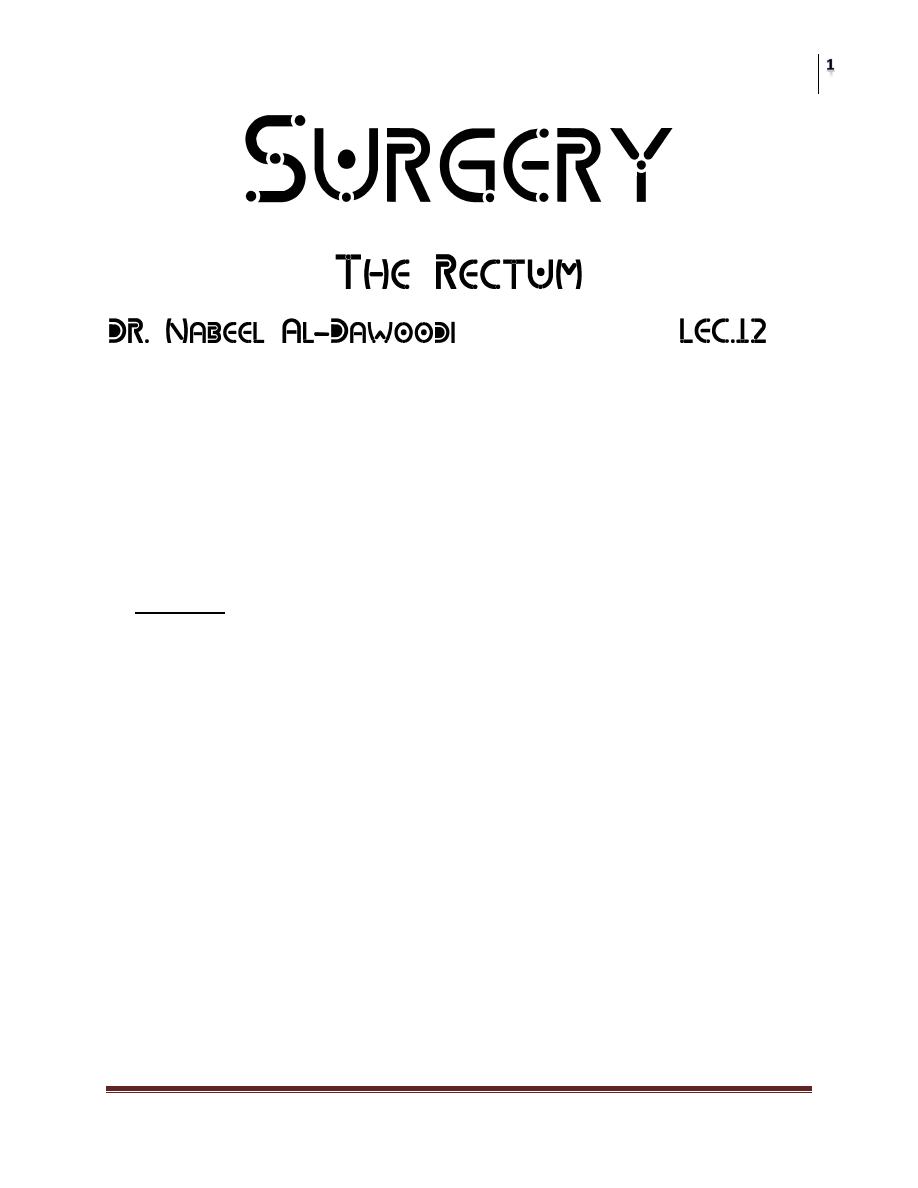
Surgery
The Rectum
Dr. Nabeel Al-Dawoodi
Lec. 12
هذه الوحبضزح هيخ هن هحبضزاد العبم السبثق والسجت انى الذكزىر رفض اعطبء:خوهه خظحلاه
الوحبضزح االصليخ ثس اظن انى هيخ نفسهخ
الذكزىر اكذ ثن اكذ انى هبيخ الوحبضزح هيخ هجزد هخزصز او رؤوس اقالم والي يزيذ يقزح يزجع للكزبة
والذكزىر اسئلزخ حست هكبل راح رجي اعزوبدا على الكزبة وليس على الوحبضزح
ثس حجيذ انجهكن على هبيخ السبلفخ
شكزا
Anatomy:
o Surgically the rectosigmoid junction lies opposite the sacral promontory.
o From here the rectum follows the curve of the sacrum ending at anorectal
junction at which point the puborectalis m. encircle the post. & lateral aspect
of the junction, creating the anorectal angle (normally=120
o
).
o The adult rectum is approx. 15 cm in length, in which it is divided onto 3
equal parts; upper, middle & lowers third; these are marked on the mucosal
aspect by the semicircular valves of Houston.
o The upper 1/3 is intraperitoneal (except its post. Surface) while the lower 2/3
is extraperitoneal.
o The lowest part of the rectum is separated by fascia of denonvilliers from the
prostate in front, & by fascia of waldeyer from the coccyx & last 2 sacral
vertebrae behind.
o These fascias are very important surgically as they are a barrier to malignant
penetration, & are vulnerable guides at operation.
o The main arterial supply of the rectum sup. Rectal a. which is the direct
continuation of the (IMA).

Surgery
The Rectum
Dr. Nabeel Al-Dawoodi
Lec. 12
o Additional supply comes from bilateral middle rectal aa. (*arise from
internal iliac artery) & from bilateral inferior rectal aa. (Arise From int.
pudendal a.).
o The rectal vv. (leading into the inf. Mesenteric v.) drains the rectum & the
proximal part of the anal canal.
o The middle rectal nodes & the sup.rectal nodes (pararectal lymph glands of
gerota) coincide ( )يتطابقwith their corresponding bl. Vessels.
o The usual drainage flow is upwards (hence the emphasis(assurance) on
achieving wide clearance of proximal lymph nodes in surgical ablation of
CA. rectum) unless the routes are blocked (e.g. by CA.), in which case the
flow may reverse.
PHYSIOLOGY:
The main functions of the rectum are absorption, storage & participation in
defecation.
SYMPTOMATOLOGY OF RECTAL DISEASES:
This includes bleeding/rectum, altered bowel habit (early morning diarrhea)
(spurious diarrhea) is a symptom of rectal CA.), mucus discharge, tenesmus,
prolapse, pruritus & wt. loss.
Rectal Tenesmus: the feeling of constantly needing to pass stools even if
bowels are already empty. It can involve pain, straining, and cramping.
Examination of the rectum must include :
1- Visual inspection of the perineum.
2- Digital exam. (P.R).
3- Proctoscopy.
4- Sigmoidoscopy (rigid 40 cm.) or flexible (60 cm).
INJURIES:
Uncommon, mechanisms include:
1- Missile.
2- Falling in a sitting posture onto spiked or blunt-pointed objects.
3- Childbirth especially forceps-assisted.
4- Serious sexual assault.

Surgery
The Rectum
Dr. Nabeel Al-Dawoodi
Lec. 12
Dx. Depends on detailed Hx. Taking + comprehensive physical exam. +
Bladder cath. To rule- associated bladder &/or urethra, in or out.
Early laparotomy is indicated; bleeders stopped devitalized tissues debrided,
perforations sutured, proximal defunctioning colostomy affected & abdominal
wound repaired in layers.
FOREIGN BODIES IN THE RECTUM: (F.B)
An astonishing variety of F.Bs. can be recovered from the rectum.
Treatment is manual extraction - - - awake or U.G.A(*under general
anesthesia) - - - laparotomy, to milk the F.B. down & deliver it per anum, is
seldom needed.
RECTAL PROLAPSE :
Occurs most often at the extremes of life – it can be partial (mucosa +
submucosa) or complete.
PARTIAL PROLAPSE:
In infants, the direct downward course of the rectum, due to the as yet
undeveloped sacral curve, + the reduced resting anal tone, predispose to this
condition.
In children, it is predisposing to by: diarrhea, sever whooping cough & wt.
loss.
it may be associated at times with: fibrocystic disease, neurological causes &
maldeveloment of pelvis.
In adults, it is usually associated with 3
rd
. degree hemorrhoid (prolapse m.
memb. is pink, prolapsed piles are plum colored & more pedunculated).
It may be predisposing to by a torn perineum (female), straining from
urethral obstruction (male), or atony of the sphincter mechanism (elderly).
TREATMENT:
In infants & young children: reassurance of parents + teaching them
digital repositioning,, if this fails after 6 – wks’trial, then submucosal injs.
Of 5% phenol in almond oil U.G.A. may prove effective.
occasionally, surgical suturing of the rectal wall to the sacrum, is required.

Surgery
The Rectum
Dr. Nabeel Al-Dawoodi
Lec. 12
In adults: submucosal injs. May be useful in early cases. In unilat. Cases
ligation (Goods all's ligature) & excision, or endoluminal stapling excision
can be effective.
COMPLETE PROLAPSE (PROCIDENTIA):
Less common than partial prolapse, it involves the protrusion of all layers of
the colon & is usually associated with a weak pelvic floor.
It commences as intussusception of the ant.rectal wall (where supporting
tissues are weakest especially in women) which gradually descends &
involves other walls.
Any prolapse > 5cm in length should contain anteriorly between its layers a
pouch of peritoneum which, in turn, may contain small bowel loops
(characteristic gurgle sound can be heard when the prolapse is reduced).
Male/Female = 1/6 .
In women rectal prolapse is commonly associated with uterine prolapse or a
past Hx. Of gynecological op. (e.g. hysterectomy).
In half of the adult cases, fecal incontinence is also present.
Rectal prolapse should be differentially diagnosed from ileocaecal
intussusception in children & from rectosigmoid intussusception in adults.
TREATMENT:
Is surgical fixation of the rectum (rectopexy) via abdominal or perineal
approaches.
*Pexy: is a surgical fixation of any organ
PROCTITIS :
Is either non-specific or related to a specific infective agent.
NON-SPECIFIC PROCTITIS:
Can be acute or chronic, it is usually confined to the rectum, but may spread
proximally.
Signs & symptoms may include: tenesmus, passage of blood and mucous,
& in severe cases of pus also.
Although the patient has a frequent intense desire to defecate, the amount of
stools passed at a time is small.

Surgery
The Rectum
Dr. Nabeel Al-Dawoodi
Lec. 12
Malaise & fever are usual in acute cases.
O/E(on examination); PR ---> the mucosa is swollen & tender.
Proctoscopy, sigmoidoscopy & colonscopy + multiptle Bxs. Are essential
for Dx.
Pathologically the inflammation affects the mucosa & to lesser extent, the
submucosa.
In 10% of cases the condition extends to involve the whole colon (total
ulcerative colitis).
Etiology is unknown but, the most acceptable hypothesis is that mild &
limited form of ulcerative colitis.
TREATMENT:
Usually the condition is self-limiting, but great symptomatic relief can be
obtained from the use of 5-aminosalicyclic acid compounds, acetarsol
suppositories(*anti-infective) or prednisolone retention enemas.
Milk should be excluded from the diet.
In severe cases, oral steroids are beneficial.
N.B.: Proctitis due to crohn’s dis. Is uncommon, it is often associated with
severe perineal dis. Characterized by fistulation.
Sigmoidoscopically the inflammation tends to be patchy & there may be
fissure, ulcers & even a cobblestone appearance.
PROCTITIS DUE TO SPECIFIC INFECTIONS:
1- Clostridium difficle:
o This may follow broad-spectrum antibiotic administration.
o A "membrane "may be seen on Proctoscopy, hence the name
pseudomembranous enterocolitis.
2- Bacillary dysentery:
Caused by Shegilla spp., the inflammation is purulent with multiple small
& shallow ulcers.
PR exam. Is painful & agglutination tests rendered it unnecessary.

Surgery
The Rectum
Dr. Nabeel Al-Dawoodi
Lec. 12
3- Amoebic dysentery:
Caused by Ent. Histolytica. The infection is more liable to be chronic &
exacerbations after a long period of freedom from symptoms often
occure.
Endoscopy is not painful.
The ulcers are {bottlenecked} i.e. they have considerably undermined
edges; they have a yellow necrotic floor, from which blood & pus exude.
In 75% of cases the ulcers are confined to the lower sigmoid & upper
rectum.
Scraping from the ulcers should be immersed in warm isotonic, saline
solution & sent to the Lab. For immediate microscopic exam.
4- Amoebic granuloma:
Presents as a soft mass, usually in the rectosigmoid region.
It can be mistaken for a CA.
Sigmoidoscopy shows an ulcerated surface, but the mass is less friable
than a CA.
Dx. Can be made on the basis of immediate microscopic exam. Of afresh
taken scraping specimen.
TRETMENT:
Metronidazole 800 mg x 3 for 7 – 10 days is very effective.
5- Tuberculous proctitis:
Is nearly always associated with active pulmonary TB. & ulceration of the
anus.
Sub mucous rectal abscesses burst & leave ulcers with an undermined edge.
Rx: Anti TB. Drugs should be given for 6-9 months
6- Gonococcal proctitis:
Occurs in both sexes as the result of rectal coitus, & in the female from
direct spread from the vulva.
In the acute stage, the m. membrane is hyperemic & thick pus can be
expressed as the Proctoscope is withdrawn.

Surgery
The Rectum
Dr. Nabeel Al-Dawoodi
Lec. 12
Bact. Exam. Can easily Diagnosed early cases, but later, when the inf.
Becomes mixed the Dx. become difficult
Rx: systemic ABTs.
7- Lymphgranuloma inguinale:
Spreads in ways similar to those of Gonococcal proctitis.
In female, inf. Spreading from the cervix via lymphatics to the pararectal
L.Ns. is common.
Proctoscopically, the finding of greatly enlarged (ing. L.Ns. + proctitis)
highly support the Dx., through the L.Ns. may be subsiding by the time
proctitis commence.
8- Primary syphilis:
A 1
o
chancre may occur inside the anus – aparadox (painless anal fissure)
9- AIDS:
May present with a particularly florid type of proctitis.
Culture may show unusual organisms, eg: CMV.
10 – Strawberry lesion of the rectosigmoid:
Is due to an infection by spirochete vincenti & bacillus fusiformis.
The main symptoms is diarrhea, often scantily blood stained.
Sigmoidoscopically the Characteristic lesion is thickened; slightly raised
mucosa with superficial ulceration in the rectosigmoid.
The inflammation memb. Oozes blood at numerous-pin points; giving the
appearance of an over ripe strawberry.
Swabs must be taken from the lesion (as well as from the gums and the
throat) and examined for vincent's and fusiform organisms.
Treatment: Acetarisoi supps. + vit.c.
11. Rectal bilharziasis:
o caused by shistosomia mansoni
o endemic in many tropical and subtropical areas especially in Nile delta.

Surgery
The Rectum
Dr. Nabeel Al-Dawoodi
Lec. 12
o The deposition of the ova in the rectum is manifested as bilharzial dysentery
(rarely deposit in the bladder *hematuria).
o In later stages papillomas foarm (sessile or pedunculated), these contain the
ova of the trematode.
o the life cycle of which resembles that of schistosoma haematobulin.
o Untreated, the rectum becomes festooned, and prolapsed of the diseased
m.memb. is usual.
Treatment:
praziquantel is effective against all schistosomia spp.; a single oral dose
mg.fKg.B.W is usually curative.
If papillomas persist despite medical Rx., they should be treated by local
destruction.
Solitary rectal ulcer:
o This is become more commonly diagnosed problem.
o Classically, it takes the form of the ulcer on the ant.rectal wall (must be
differentiated Ca. or I.B.D., particularly crohn's dis.).
o The cause is the combination of ant.rectal wall prolapse + an increase in the
intrarectal pressure, due to chronic straining as result of constipation.
o Although benign, the condition is difficult to treat.
o Abdominal rectopexy can give symptomatic relief from bleeding and
discharge. Rarely rectal excision is required.
Rectal tumors:
Benign tumors:
o The rectum, along with the sigmoid colon, is the most frequent site of
polyps and cancers in the G.I.T.
o Most neoplastic adenomatous polyps of the colorectum have the tendency
to become malignant, especially those that are sessile (Vs.pedunculated),
and more than 1cm. in diameter (adenoma-carcinoma theory).
o For these reasons, total removal of all polyps is a must, to achieve
complete histological exam. and exclude or confirm C.I.S., also prevent
local recurrence.

Surgery
The Rectum
Dr. Nabeel Al-Dawoodi
Lec. 12
o No rectal tumours should be removed until the possibility of a proximal
CA. has been ruled out, because the occurrence synchronous tumors are
not uncommon.
1-Rectal polyps:
a) Juvenile polyps: this is a bright-red glistening pedunculated sphere
(cherry tumour) which is found in infants and children, it may cause
bleeding, or pain if it is prolapses during defecation. Malignant potential
is nill. It often separates itself, but can be removed
easily surgically.
b) Metaplastic polyps: These are small, pinkish, sessile polyps, 2-4 mm.
in diameter and frequently multiple. They are harmless.
c) Inflammatory polyps or pseudopolyps: these are edematous bosses
of m.memb.. they are usually associated with
U.colitis, but most inflammatory diseases can cause
them.
d) Villous adenomas: these have a charecteristic frond_like appearance.
They are usually large, and their malignant potential
is proportional to their size. Rarely, the profuse
mocous discharge from these tumours, which is in
potasium, cause dangerous electrolyte and fluid
losses, eg.. hypokalemia.
Treatment: surgical exicion either per anum or through labrotomy.
e) Familiar adenomatous polyposis (FAP) (formerly known as familiar
polyposis coli):
this disease usually manifests itself by the development of multiple
colorectal polyps around puberty, it is
inhereted as Mandelian dominant trait, and the gene
responsible (adenomatous polyposis cell [APC] gene) is
located on the short arm of chromosome 5.
Male/female=1. Screening affected families is cost- effective.
It can also occur sporadically by new mutations.
The condition is premalignant, hence total colectomy is advised.

Surgery
The Rectum
Dr. Nabeel Al-Dawoodi
Lec. 12
D.DX.: in any country where belharzaisis is rife, rectal polyps
should be differentialy diagnosed from belharzial papillomas.
Treatment of rectal polyps:
Small polyps diathermy coagulation + regular F.U. (recurrence is
common) is satisfactory.
For large polyps, especially the sessile type, rectal excision is suitable.
2- Benign lymphoma:
Can occur at all ages and both sexes.
It occurs as a circumscribed movable nodule, firm, graysh-white to pink in
color, and essentially sub mucousal.
It has no definite capsule.
Rx.: local excision.
3- Endometrioma:
This is rare and frequently misdiagnosed as CA.
it produces either a constricting lesion of rectosigmoid or a mass invading
the rectum from the rectovaginal septum.
Occurring between 20 and 40 yrs. Of age.
Rx.:
contraceptive pills and less often,
bil. Oophorectomy(*ovariectomy) is needed to induce regression of the
mass.
4- Haemangioma:
Is uncommon, it may cause serious bleeding (or fatal one, if the tumour
was large).
When localized in the lower part of the rectum or anal canal, it may be
excised after applying Goodsall's ligature.
Higher up or diffuse lesions stimulate U.colitis in symptomatogly, hence
the Dx. Is missed for a long period.
Rx.: is excision of that portion of the anorectum bearing the neoplasm.

Surgery
The Rectum
Dr. Nabeel Al-Dawoodi
Lec. 12
5-Gastrointestinal stromal tumour (GIST) formerly leiomyma:
Rare they consist of spindle cells.
Rx. Is excision.
The malignant counterparkmalign. (GIST)-formerly leiomyosarcorma
should be treated by radical excision.
Carcinoma:
o Colorectal carcinomas are the 4
th
most common carcinomas in females, and
the 2
nd
most common in males.
o The rectum is the most common site involved .
o In many cases , the presence of one or more synchronous adenomas or
papillomas, in the operation specimen in addition to the carcinomas, is a
proof that ADENOMAS and PAPILLOMAS are PREMALEGNAT
conditions (adenoma to carcinoma sequence).
o In 5% of cases, there is more than one CA. present (synchronous tumors ).
PATHOLOGIC HISTOLOGY:
The vast majority of CA.rectum cases are COLUMNAR-CELL
ADENOCARCINOMAS.
3 GRADES ARE RECOGNIZED: (figure 1)
1. well differentiated adenocarcinoma found in 11% .(prognosis is
good)
2. averagely differentiated adenocarcinoma found in 64% .
(prognosis is fair )
3. anaplastic highly un differentiated adenocarcinomas found in 25%
(prognosis is poor)
MORPHOLOGY
TYPES include: Ulcerative, Papilliferous, Infiltrative CA.

Surgery
The Rectum
Dr. Nabeel Al-Dawoodi
Lec. 12
TYPES OF SPREAD :
1. LOCAL SPREAD:
o Is circumferential rather than longitudinal, a period of months is needed
for involvement of a quarter of the circumference.
o The ANNULAR type is common at the RECTOSIGMIODAL
JUNCTION.
o After penetrating the muscular coat, the growth spread into the
surrounding mesorectum, and then the fascia propria is penetrated after
about 18 months.
o Anterior penetration will involve the PROSTATE, SEMINAL VESICAL
or the BLADDER in MALE & VAGINA & UTERUS in FEMALE.
o LATERAL penetration will involve the URETER in BOTH GENDRES
while POSTERIOR penetration may involve the SACRUM & SACRAL
PLEXUS.
o DOWNWARD spread for more than few Cms. Are RARE except in
ANAPLASTIC tumors. (figure 2)
2- LYMPHATIC SPREAD: (figure 3)
o L.N enlargement from bacterial infection is more frequent than
enlargement from metastasis.
o Lymphatic spread from CA.RECTUM above the peritoneum reflection
occurs almost exclusively in an UPWARD direction ; below that level
to within 1-2 cm of the anal verge the lymphatic spread is still upward
but the first halting place is the pararectal L.Ns.of GEROTA.
o Tumors lying within the field of middle rectal a. (4-8 cm from anus) are
exceptional ,1
st
degree lateral spread may go to lymphatics
accompanying the middle rectal vein .
o Downward spread is RARE; groin L.Ns. draining the perianal rosette
and the epithelial lining of the distal 1-2 cm of the anal canal will get
2
nd
degree spread via subcutaneous lymphatics .
o 2
nd
station L.Ns. are reached only late .Atypical and widespread
lymphatic permeation can occur in anaplastic CA.

Surgery
The Rectum
Dr. Nabeel Al-Dawoodi
Lec. 12
3- VENOUS SPREAD
o Is generally late , except for anal canal lesion.
o Virulent tumors are more liable to spread hematogenously.
o This rout will reach the LIVER 34% , LUNG 22% ,ADRENALS 11%
MISCELLANEOUS 33%.
4- PERITONEAL SPREAD
May follow penetration of the peritoneum by an high lying CA. rectum.
STAGES OF PROGRESSION
AS
A RULE CA. rectum DOES NOT metastasize early
1- DUKE’S STAGING
A. The growth is limited to the rectal wall 15% (prognosis is excellent ).
B. The growth is extended to the external tissue, but NO metastasis to the
regional lymph nodes 35% ( prognosis is reasonable).
C. There are 2
nd
degree deposits in the regional L.Ns. (50%). These are
subdivided into C1, in which the pararectal L.Ns alone are involved. C2 ,in
which the nodes along the supplying blood vessels are implicated up to the
point of division . Because this didn’t take into account more advanced cases
, scientists added;
D. This signifies the presence of distant metastasis, usually hepatic .other
staging systems to improve prognosis accuracy (e.g. Astler-coller
modification of Duke’s staging ) do exist but the T.N.M(T=tumor ,N=lymph
node ,M=metastasis ) classification (I.U.C.C)is internationally recognized as
the optimum one.
(*I.U.C.C.=international union of cancer control)
2- T.N.M STAGING:
and whether it has invaded nearby tissue,
(spread of cancer from one body part to
another).

Surgery
The Rectum
Dr. Nabeel Al-Dawoodi
Lec. 12
CLINICAL FEATURES:
o C.A rectum can occur early in life ,however it usually affects adults >55 yrs.
Of age .
o Early symptoms are subtle –causing delayed seek for advice or defaulting.
1- BLEEDING:
Is the earliest and most common symptom. it is often slight and occurs at the
end of defecation ,hence in every aspect it stimulates haemorrhoids (the two
conditions may coexist )
2- SENSE OF INCOMPLETE DEFOCATION(TENESMUS):
A painful straining to empty the bowel without resultant evacuation .this is a
VERY IMPORTANT & EARLY symptom.
3- ALTERATION IN BOWEL HABIT:
Is the next most frequent symptom it may lead the patient to use an aperient to
the dose that diarrhoea may ensue.
Annular rectosigmoid tumors usually cause increasing COSTIPATION while
those of the RECTAL AMPULLA usually cause an early morning BLOODY
DIARRHOEA .
4- PAIN: IS a LATE symptom ; but COLICKY pain may accompany
ADVANCED CA. of the RECTOSIGMOID area (partial intestinal obstruction
). Rectum invading the bladder or the prostate causes SEVERE pain.
5- WEIGHT LOSS: usually indicates HEPATIC metastasis.
INVESTIGATIONS
In 90% of cases tumors can be felt digitally , the borders of the tumor , it’s
surface & base sould be scrutinized .
after withdrawing the finger it should be inspected for the presence of blood
, mucopurulent materials tinged with blood.
Low L.Ns. can sometimes be felt. (In female P.V. must be done as well
because anterior wall tumors can accurately be palpated with one finger in
the vagina & another in the rectum .
A. PROCTOSIGMOIDOSCOPY:

Surgery
The Rectum
Dr. Nabeel Al-Dawoodi
Lec. 12
Will always show the tumor (if present )provided that the rectum is
emptied of stool beforehand .
B. BIOPSY(Bx.):
By way of sigmoidoscop e , a portion of the edge of the tumor can be
removed by Bx. Forceps . (multiple Bxs. Are preferred) .
C. COLONOSCOPY
Is mandatory (before or after the operation ) to exclude any
synchronous tumors (adenoma or carcinoma ). If colonoscopy is
not possible , a BARIUM ENEMA should be performed .
DIFERRENTIAL DIAGNOSIS:
Rectal adenoma
Inflammatory stricture
Amoebic granuloma
Endometrioma
Carcinoid tumours
Solitary rectal ulcer syndrome
TREATMENT:
Some form of excision of the rectum is essential , if possible , because of the
extreme suffering entailed if the neoplasm remains .
Before operation ,however , the fitness of the patient for surgery & the
extent of spread of the tumour should be assessed , because both are going
to influence the operative strategy.
Assessment of the tumour spread is effected by utilizing EUS , MRI ,or C.T.
scan ,whereas CHEST X-RAYS , ULTRASOUND of the abdomen C.T or
PET scan of the liver & chest can be used to detect distant metastasis ( if
present).
PRE-OPERATIVE PREPARATION NECESSITATE :
1- Mechanical bowel lavage (preoperative or on-table , in the rare
cases of intestinal obstruction ) .
2- Prophylactic antibiotics .
3- Informed consent .
4- Counselling & sitting of stomas .
5- Correction of anemia & electrolyte imbalance .
6- Cross-matching of blood .

Surgery
The Rectum
Dr. Nabeel Al-Dawoodi
Lec. 12
7- D.V.T prophylaxis .
8- Insertion of urethral catheter .
Radical excision of the rectum , together with the mesorectum &
associated L.Ns. (TME =total mesorectal excision ) is the aim . Even in
presence of <4 liver secondaries ,does not rule out the feasibility of a
radical excision , which will double the survival rate from 2 to 5 years if
combined with resection of secondaries , either at the time of
proctectomy or subsequently .
Locally advanced tumours should be down staged be preoperative
D.X.T. to render them radically resectable. Indeed ,neoadjuvant RT.
decreases local recurrence rate in ALL rectal CA. cases .
When proctoectomy is possible , the aim should be restoration of GIT
continuity & continence by preserving the anal sphincter, Thus a sphincter-
saving operation (anterior resection ) is suitable for tumours of the upper
2/3s of the rectum . This is applied to at least 2/3s of patients presenting
with CA.rectum . Although proctoectomy with permanent colostomy
(abdominoperineal excision ) is often required for tumour of the Lower 1/3
of the rectum (figure 6) , the introduction of the STAPLING GUN has
enabled many more of these patients to be treated by Sphincter-saving
procedure , provided that a minimum distal margin of clearance of 2cm. can
be secured .
All these operations can be done through LAPAROTOMY incision or by
LAPAROSCOPY .
POST-OPERATIVE CARE
1- I.V. fluids.
2- N.G suction.
3- Blood transfusion (if necessary )
4- Urethral catheter connected to closed drainage system (kept for 5
days )
5- Potent analgesics.
6- Antibiotics including Metronidazol .

Surgery
The Rectum
Dr. Nabeel Al-Dawoodi
Lec. 12
Carcinoid tumour
Like benign lymphoma, carcinoid tumour originates in the submucosa,
with the mucous membrane over it being intact.
Consequently, it seldom produces evidence of its presence in the
early stages, when it presents as a small plaque-like elevation.
The incidence of clinical malignancy, i.e. the occurrence of
metastases, is 10%. This is much less than that for carcinoid
tumour of the small intestine, but it is greater than that for carcinoid
tumour of the appendix. Multiple primary carcinoid tumours
of the rectum are not infrequent. The neoplasm is of slow progression,
and usually metastasises late. Large carcinoids (over
2 cm) are almost always malignant.
Treatment
Local excision is sufficient treatment for small carcinoids.
Resection of the rectum is advisable if the growth is more than
2.5 cm in diameter, if recurrence follows local excision or if the
growth is fixed to the perirectal tissues. Even when metastases are
present, resection may prolong life.
